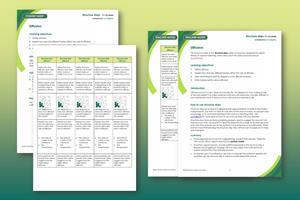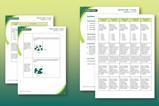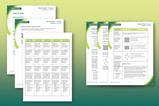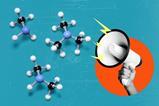Support learners to retrieve information about the diffusion process
This resource is part of the Structure strips series of resources, designed to support literacy in science teaching.
Learning objectives
- Define diffusion.
- Explain how and why different factors affect the rate of diffusion.
- Draw and interpret particle diagrams of the diffusion process.
- Write independently about diffusion.
Introduction
Diffusion occurs in many areas of everyday life. We depend on it for making a cup of tea and exploit it to make ourselves smell nice with perfumes. Crucially, diffusion is how substances move in and out of our cells and so is essential to life.
How to use structure strips
Structure strips are a type of scaffolding that support learners to retrieve information independently. Use them to take an overview at the start of a topic, to activate prior knowledge, or to summarise learning at the end of a teaching topic. Read more ideas on how to use structure strips with your learners.
Structure strips have sections containing prompts, sized to suggest the amount that learners must write. Ask learners to glue the strips into the margin of an exercise book and write their answers next to the sections, in full sentences or in bullet points. When learners have finished using the structure strip, they will have an A4 page set of notes and examples.
Scaffolding
- Encourage learners to use the suggested key words in their answers
- To further support learners, include additional prompts in the structure strip. If learners are struggling to engage with the task, supply them with sentence starters created from the model answers.
- As learners grow in confidence, ask them to attempt the extension question first and then use the structure strip to improve or self-assess their answer.
Metacognition
This resource supports learners to develop their metacognitive skills in three key areas.
- Planning: the strips provide scaffolding to plan the written response. Learners will decide where to gather information from (textbooks, own notes, revision websites). Ask learners: is the source of information you are using reliable?
- Monitoring: learners are prompted by the questions in the structure strip and can check their own answer against the prompts. Ask learners: have you covered all of the prompts in the space provided? Do you need to change anything to complete the task?
- Evaluation: learners can self-assess or ask a peer to check their work against the answers. Ask learners: did you achieve what you meant to achieve? What might you do differently another time?
More resources
- Explore diffusion with this simple microscale diffusion of a gas experiment.
- Use this sweet Exhibition chemistry demonstration to demonstrate diffusion, density and the particle model.
- Highlight diverse careers with our Chemistry: making the difference videos and let your learners be inspired. For example, Saba’s air quality assessments help clients worldwide to minimise their air pollution.
Key words
Diffusion, solid, liquid, gas, concentration.
Extension question
Jack is sat at the back of the classroom and sprays his body spray. He thinks the teacher who is by the board at the front of the class won’t notice.
Write a note in bullet points to explain to Jack why the teacher will eventually smell his body spray but might not know that it was him who sprayed something.
Answers
Find suggested answers for the structure strip in the teacher notes.
Example answer to extension question
Look for scientific reasoning in the creative writing.
- Jack, your teacher will smell your body spray because of diffusion!
- The scent particles will be concentrated where you spray it (e.g. under your shirt). However, as the scent is in aerosol form it will diffuse (learners may not use the term aerosol but look for some understanding that the scent is in gas form or evaporates from a warm body).
- When it diffuses the scent particles spread out as they move from an area of high concentration to an area of low concentration. The rest of the classroom is an area of low concentration so eventually the smell will spread throughout the room, even to the teacher.
- The good news is that diffusion happens in all directions because the movement of particles in gases is random, so your teacher won’t necessarily know it was you!
Downloads
Diffusion structure strip student sheet
Handout | PDF, Size 0.14 mbDiffusion structure strip teacher notes and answers
Handout | PDF, Size 0.18 mbDiffusion structure strip student sheet
Editable handout | Word, Size 0.45 mbDiffusion structure strip teacher notes and answers
Editable handout | Word, Size 0.47 mb
























No comments yet